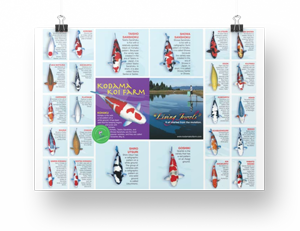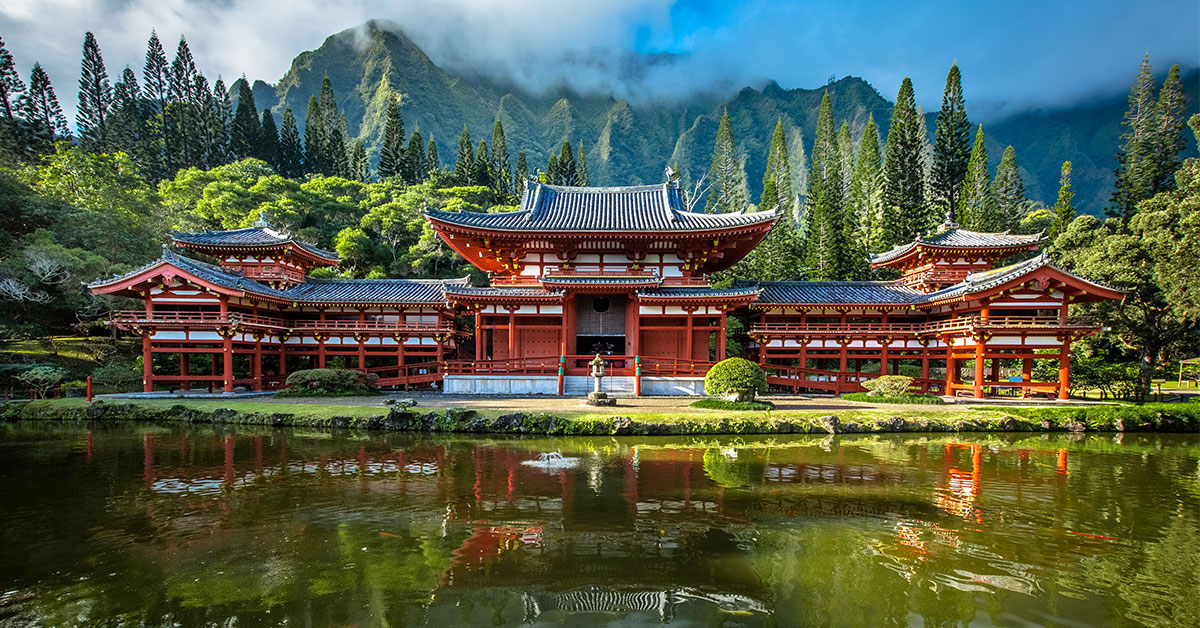
Japanese shrines and temples hold a significant place in the cultural and historical tapestry of Japan. They serve as sanctuaries of spirituality, cultural preservation, and natural beauty.
These sacred sites, steeped in centuries-old traditions, offer a serene escape from the bustling modern world and provide a space for contemplation, worship, and community gatherings. They are not only religious centers but also custodians of Japan’s rich heritage, art, and architecture. Integral to many of these sites are koi ponds, which symbolize perseverance, strength, and beauty, further enriching the cultural and spiritual experience.
The Best Japanese Shrines and Temples with Koi Ponds:
- Byodo-In Temple (Uji, Kyoto)
- Ryoanji Temple (Kyoto)
- Heian Shrine (Kyoto)
- Meiji Shrine (Tokyo)
- Kinkaku-ji (The Golden Pavilion, Kyoto)
- Tenryu-ji Temple (Kyoto)
- Nemichi Shrine (Seki, Gifu Prefecture)
- Senso-Ji Temple (Tokyo)
There are a large number of famous Japanese koi fish pond and gardens, these 8 are our favorites due to their beauty and large ponds with koi fish. Let us know which ones we missed in the comments below.
Why Were Japanese Shrines and Temples Created?
Japanese shrines and temples are primarily used for religious rituals, festivals, and ceremonies that mark important events in the Shinto and Buddhist calendars. Visitors come to pray for good fortune, health, and success, or to honor their ancestors. These sites often host seasonal festivals that celebrate nature’s cycles, drawing large crowds to witness traditional performances and rituals. Beyond their religious functions, shrines and temples are popular tourist attractions, offering a glimpse into Japan’s spiritual and cultural legacy.
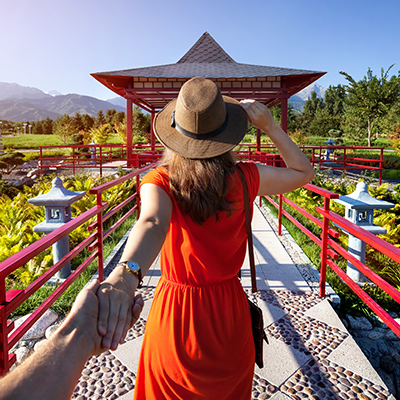
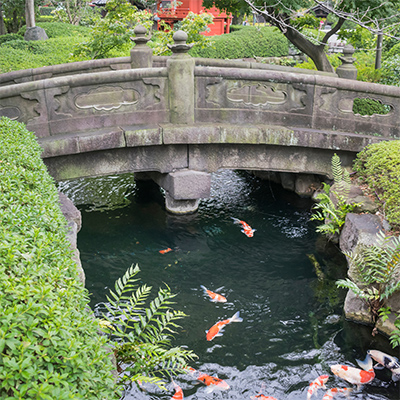
What’s the Purpose of Koi Ponds in Temples?
Koi ponds at these shrines and temples play a vital role in enhancing the peaceful and reflective ambiance. Koi, or nishikigoi in Japanese, are not only admired for their vibrant colors and patterns but also revered for their symbolic meanings.
In Japanese culture, koi are associated with perseverance, strength, and the ability to overcome adversity, reflecting the spiritual resilience promoted by these sacred sites. The sight of koi swimming gracefully in clear waters adds to the aesthetic and meditative qualities of the gardens, inviting visitors to pause, reflect, and connect with nature and history. The care and maintenance of these koi ponds demonstrate the harmonious relationship between human artistry and the natural world, a core value in Japanese cultural and spiritual practices.
8 Beautiful Temples & Shrines in Japan:
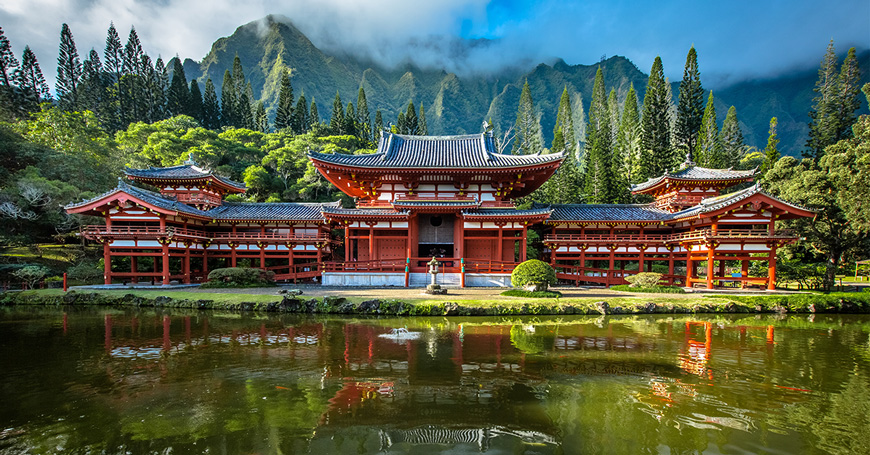
1. Byodo-In Temple (Uji, Kyoto)
Description and History: Byodo-In Temple, a UNESCO World Heritage Site, was originally built in 998 as a rural villa for the powerful Fujiwara clan. In 1052, it was converted into a temple by Fujiwara no Yorimichi. The most iconic structure, the Phoenix Hall (Houou-do), was completed in 1053 and is named after the pair of phoenix statues on its roof. This hall is an architectural masterpiece and houses a statue of the Amida Buddha, crafted by the renowned sculptor Jocho.
Koi Pond Details:
- Size: Approximately 130 meters in length and 70 meters in width.
- Depth: Varies from 1 to 2 meters.
- Koi Types: Kohaku, Taisho Sanshoku, Showa Sanshoku.
- Other Features: The pond is surrounded by beautifully manicured gardens, and the reflection of the Phoenix Hall in the pond is particularly striking. The serene setting enhances the spiritual ambiance of the temple.
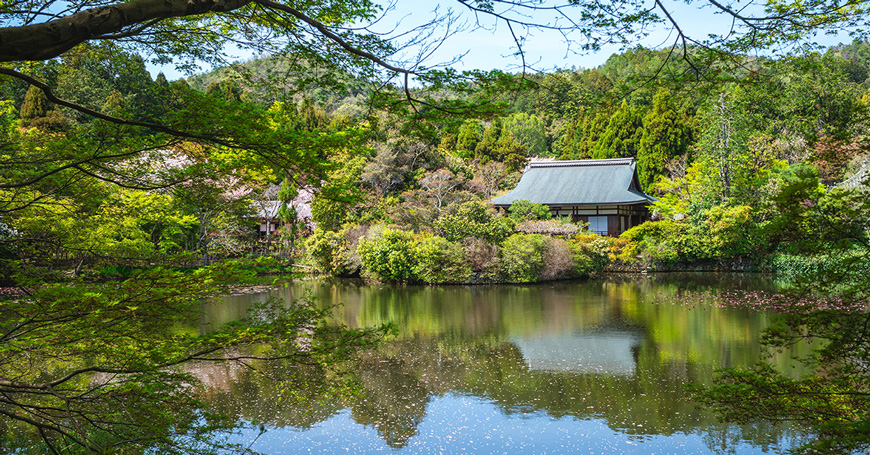
2. Ryoanji Temple (Kyoto)
Description and History: Ryoanji Temple is famous for its karesansui (dry landscape) rock garden, which dates back to the late 15th century. Established in 1450 by Hosokawa Katsumoto, the temple belongs to the Myoshin-ji school of the Rinzai branch of Zen Buddhism. The exact origins and meaning of the rock garden remain a mystery, contributing to its allure and the meditative experience it offers.
Koi Pond Details:
- Size: About 330 meters in circumference.
- Depth: Varies between 1 to 2 meters.
- Koi Types: Kohaku, Sanke, Ogon.
- Other Features: Kyoyochi Pond, dating back to the Heian Period, is surrounded by lush greenery and seasonal flowers, providing a tranquil environment. The pond’s serene setting contrasts with the minimalistic rock garden, offering visitors a different type of meditative experience.
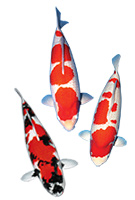
Sign up for our newsletter to learn more about koi varieties and receive a 10% off coupon!
Not only will you receive regular emails in your inbox about top koi varieties, we’ll also send you a FREE Koi Varieties printable poster and a 10% off coupon toward your first koi purchase.
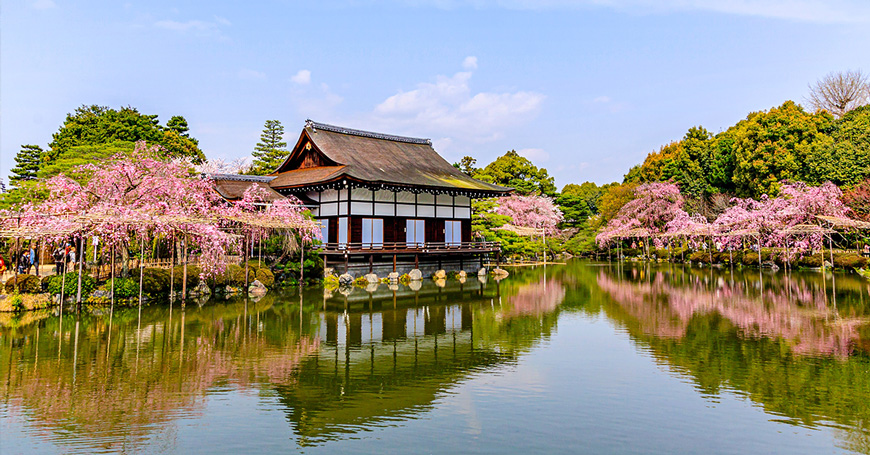
3. Heian Shrine (Kyoto)
Description and History: Heian Shrine, established in 1895 to commemorate the 1100th anniversary of Kyoto’s founding, is dedicated to Emperor Kanmu and Emperor Komei. The shrine’s design replicates the architecture of the Heian Period, with its bright vermilion buildings and expansive gardens. The shrine plays a significant role in various cultural and religious festivals, including the annual Jidai Matsuri (Festival of Ages).
Koi Pond Details:
- Size: The pond is expansive, with a perimeter of about 550 meters.
- Depth: Generally around 1.5 meters deep.
- Koi Types: Asagi, Bekko, Shusui.
- Other Features: The garden features weeping cherry trees, irises, and bridges like the Taihei-kaku (Bridge of Peace), which spans the pond, offering visitors a close view of the koi. The pond’s design is meant to reflect the elegant aesthetics of the Heian Period.
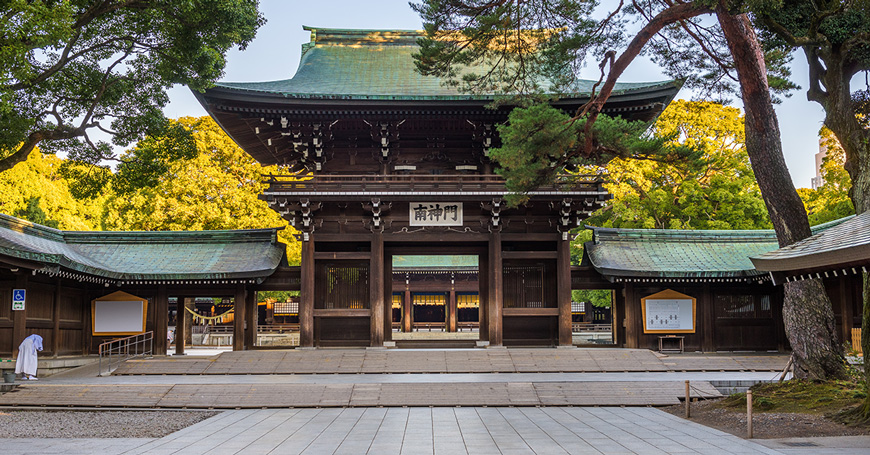
4. Meiji Shrine (Tokyo)
Description and History: Meiji Shrine, dedicated to Emperor Meiji and Empress Shoken, was completed in 1920. Situated in a vast forested area in central Tokyo, the shrine is an oasis of tranquility amidst the urban hustle. It serves as a major site for traditional Shinto rituals and ceremonies, including weddings and seasonal festivals.
Koi Pond Details:
- Size: Approximately 500 square meters.
- Depth: Around 1 to 1.5 meters.
- Koi Types: Kujaku, Ginrin, Goshiki.
- Other Features: The pond is surrounded by iris gardens, which bloom spectacularly in June. The lush greenery and serene water create a peaceful retreat, making it a popular spot for meditation and relaxation.
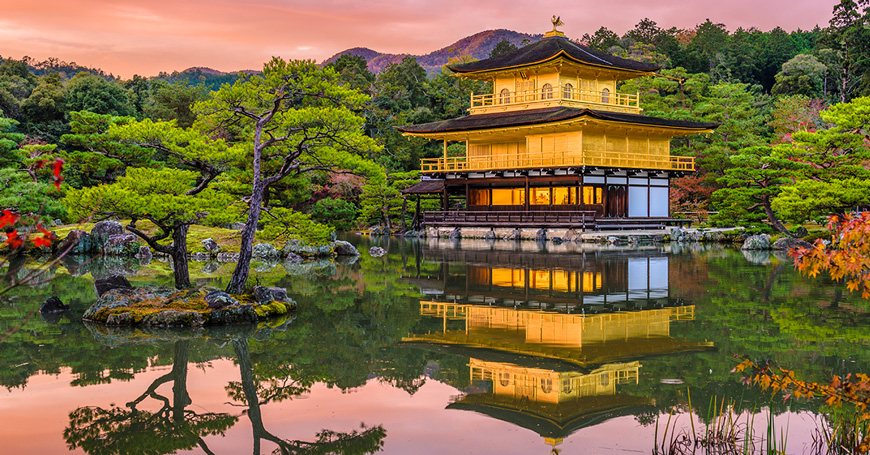
5. Kinkaku-ji (The Golden Pavilion, Kyoto)
Description and History: Kinkaku-ji, originally built in 1397 as a retirement villa for shogun Ashikaga Yoshimitsu, became a Zen temple after his death. The Golden Pavilion, covered in gold leaf, is the temple’s most famous feature. The temple has been rebuilt several times, with the current structure dating back to 1955 after a fire in 1950.
Koi Pond Details:
- Size: Kyoko-chi (Mirror Pond) covers about 2,500 square meters.
- Depth: Varies, with some parts reaching up to 2 meters.
- Koi Types: Tancho, Utsurimono, Hikarimono.
- Other Features: The pond includes several small islands and rocks, reflecting the Golden Pavilion, especially striking during autumn and winter. The pond’s design is intended to showcase the pavilion’s beauty from multiple angles.
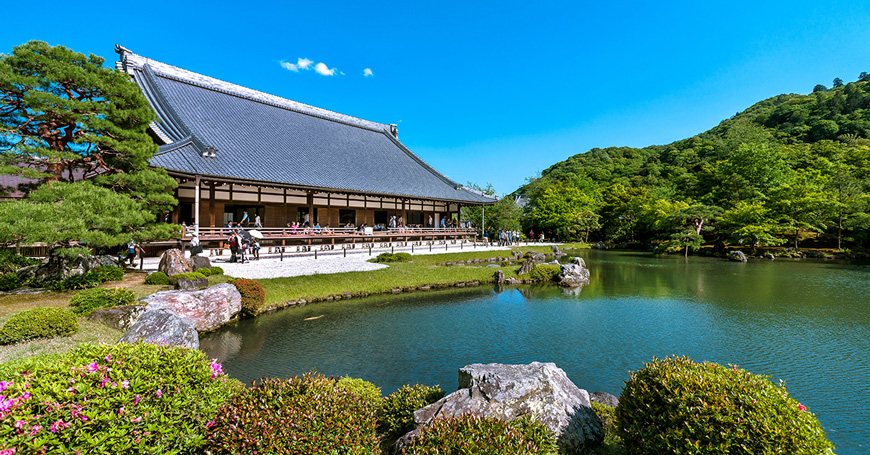
6. Tenryu-ji Temple (Kyoto)
Description and History: Tenryu-ji, a UNESCO World Heritage Site, was established in 1339 by shogun Ashikaga Takauji in memory of Emperor Go-Daigo. The temple is the head of the Tenryu-ji branch of Rinzai Zen Buddhism. The Sogenchi Teien garden, designed by Muso Soseki, is considered one of Japan’s finest examples of landscape design.
Koi Pond Details:
- Size: Approximately 1,200 square meters.
- Depth: Around 1.5 meters.
- Koi Types: Doitsu, Yamabuki, Goromo.
- Other Features: The pond is part of a landscape garden designed by Muso Soseki, with stunning views of the surrounding mountains and seasonal changes in foliage. The garden’s design harmonizes with the natural scenery, creating a seamless blend between the constructed environment and nature.
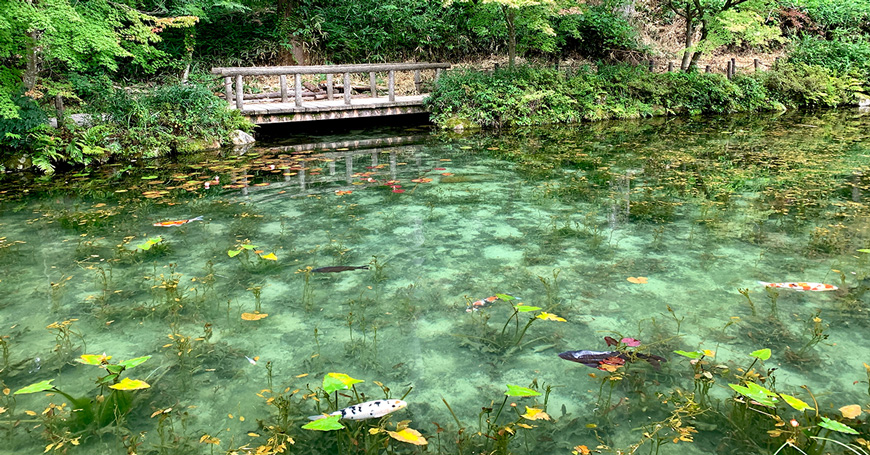
7. Nemichi Shrine, Monets Pond (Seki, Gifu Prefecture)
Description and History: Nemichi Shrine, located in Seki, Gifu Prefecture, is a Shinto shrine founded in the mid-9th century, although concrete historical records date back to the early Edo period. The shrine is renowned for its serene and picturesque setting, attracting both worshippers and tourists.
Koi Pond Details:
- Size: Known as the “Pond with no name,” commonly referred to as “Monet’s Pond.”
- Depth: Varies, generally around 1 to 1.5 meters.
- Koi Types: A variety of brightly colored koi, resembling the aesthetic of Monet’s paintings.
- Other Features: The pond is famed for its clear waters, water lilies, and surrounding lush greenery, offering a scene reminiscent of Claude Monet’s impressionist works.
Significance: Nemichi Shrine’s koi pond, with its vivid colors and tranquil ambiance, not only enhances the spiritual experience of visitors but also embodies the harmonious relationship between nature and art in Japanese culture. The serene setting invites contemplation and underscores the cultural importance of koi in Japanese shrines.
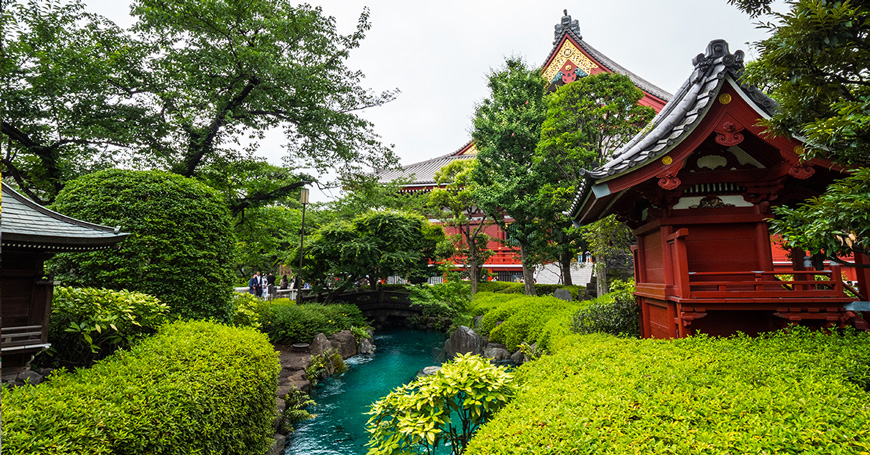
8. Senso-ji Temple (Tokyo)
Description and History: Senso-ji, Tokyo’s oldest temple, dates back to 645 AD. Located in Asakusa, it is dedicated to Kannon, the Buddhist goddess of mercy. The temple’s history is rooted in legend: two fishermen found a statue of Kannon in the Sumida River, which became the temple’s revered object. Senso-ji has been a center of pilgrimage and worship for centuries and continues to be a bustling cultural and spiritual hub.
Koi Pond Details:
- Size: Multiple smaller ponds throughout the temple grounds.
- Depth: Generally around 1 to 1.5 meters.
- Koi Types: Varieties like Kohaku, Sanke, and Ogon.
- Other Features: The ponds are integrated into beautifully landscaped gardens, with bridges, stone lanterns, and seasonal flowers enhancing the serene atmosphere. The koi ponds offer a peaceful retreat within the bustling temple grounds, reflecting the temple’s commitment to harmony between nature and spirituality.
Significance: The koi ponds at Senso-ji not only add to the aesthetic appeal but also serve as symbols of tranquility and perseverance. They provide a serene environment for reflection and meditation, enriching the spiritual experience of visitors. The harmonious integration of koi ponds with traditional temple architecture and gardens exemplifies the deep cultural connection between nature and spirituality in Japan.
Join Kodama Koi Newsletter
Get insider knowledge and sign up for our Kodama Koi newsletter to receive a free koi varieties poster! New subscribers will also receive a 10% off coupon for kodamakoisupply.com when joining.
The Significance of Koi in Japanese Shrines, Temples, & Ponds
Koi fish are symbols of perseverance, strength, and resilience, qualities that resonate deeply within the context of Japan’s spiritual and historical narrative. Their integration into the sacred environments of shrines and temples underscores their importance and the intricate relationship between nature and spirituality in Japanese tradition.
Symbolism and Spirituality: Koi are often celebrated for their ability to swim upstream, a trait that symbolizes perseverance and determination in the face of adversity. This symbolism aligns perfectly with the ethos of many shrines and temples, which are places of reflection, spiritual growth, and resilience. In Buddhist philosophy, koi are seen as representations of courage and tenacity, qualities that are cultivated through meditation and spiritual practice. The sight of koi swimming gracefully in the serene ponds of these sacred sites serves as a powerful reminder of the virtues of patience and perseverance.
Aesthetic and Meditative Qualities: The presence of koi in temple and shrine ponds enhances the tranquil and meditative qualities of these spaces. The gentle movement of the koi in clear, still waters creates a calming effect, inviting visitors to pause and reflect. This peaceful interaction with nature is a core aspect of the spiritual experience at these sites. The ponds themselves are often designed to reflect the natural beauty and harmony that are central to Japanese aesthetics, and the koi, with their vivid colors and elegant forms, play a crucial role in this visual and sensory harmony.
Cultural Heritage and Continuity: Maintaining koi ponds at shrines and temples is also an act of preserving cultural heritage. These ponds are meticulously cared for, reflecting a tradition of respect and reverence for nature that has been passed down through generations. The selection and breeding of koi have become an art form in itself, with specific varieties chosen to complement the overall design and ambiance of the gardens. This practice not only honors the past but also ensures that the beauty and symbolism of koi continue to inspire future generations.
Integration with Rituals and Festivals: Koi ponds often play a role in the various rituals and festivals held at shrines and temples. During seasonal festivals, such as those celebrating the New Year or the changing seasons, the ponds become focal points of the festivities. Visitors may feed the koi as an act of offering, symbolizing the giving of sustenance and care to all living beings. These interactions create a sense of connection and continuity between people, nature, and the divine, reinforcing the holistic worldview that is central to Japanese spirituality.
Educational and Environmental Significance: Many shrines and temples also serve as centers for environmental education and conservation. The koi ponds, with their delicate ecosystems, become living classrooms where visitors can learn about the importance of biodiversity and environmental stewardship. The care of these ponds reflects broader environmental values, emphasizing the need to live in harmony with nature and to protect and nurture the natural world.
Where to See Koi Fish in Tokyo and Other Regions of Japan?
If you’re visiting Tokyo and want to see koi fish, there are several serene spots that you shouldn’t miss. Start with the Shinjuku Gyoen National Garden, which features large ponds teeming with vibrant koi, offering a tranquil escape from the city’s hustle and bustle. The Imperial Palace East Gardens also provide a peaceful setting with its beautiful ponds where koi fish glide gracefully.
Another must-visit is the Rikugien Garden, known for its classical landscaping and picturesque pond filled with koi. Additionally, the Hama-rikyu Gardens, with its seawater ponds and teahouse, is a perfect spot to enjoy the sight of colorful koi fish in a historic setting. These locations in Tokyo offer a delightful opportunity to experience the beauty and tranquility of koi ponds.
If you’re interested in seeing koi fish in other regions of Japan, there are several remarkable places you should consider visiting.
In Kyoto, the serene Kinkaku-ji (Golden Pavilion) and Ryoan-ji Temple offer beautiful ponds filled with koi, set against stunning historic backdrops. Nara, known for its historic temples, has the Isuien Garden and Yoshikien Garden, both featuring lovely koi ponds. The Kenrokuen Garden in Kanazawa is renowned for its beauty and its ponds with colorful koi fish. In Hiroshima, the Shukkeien Garden presents a miniature landscape with a central pond filled with koi. We always recommend you take a Niigata Koi Trip and can even go with Taro Kodama!
Conclusion on Koi Fish in Japanese Temple Ponds
The presence of koi in the ponds of Japanese shrines and temples is a testament to the profound respect and reverence that Japanese culture holds for these magnificent fish. They are more than just decorative elements; they are symbols of enduring values and spiritual truths. The tranquil beauty of koi ponds enhances the meditative and aesthetic experience of these sacred spaces, offering visitors a moment of peace and reflection in their busy lives. As living symbols of perseverance, strength, and harmony with nature, koi embody the essence of Japanese spirituality and cultural heritage, enriching the sacred environments of shrines and temples and connecting the past with the present and the future.

